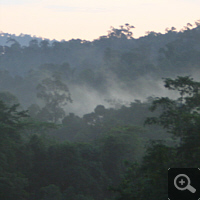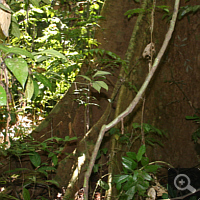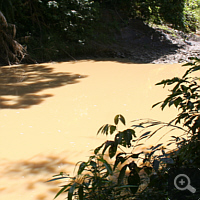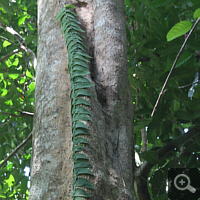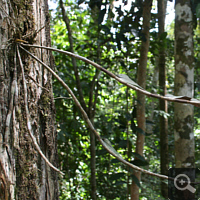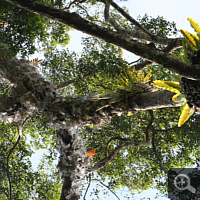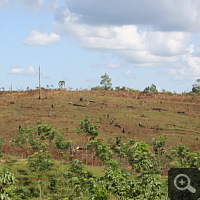Tropical Ecology
The rainforest provides itself with its typical climate.

Gentle reader,
each of us has comprehensive ideas about the tropics. A lush growth, tremendous jungle giants of noble wood, the branches cluttered with bromeliads, ferns and orchids. Between the trees lianas span themself like a spiderweb. Triads of insects – terwithes, leaf-cutting ants, strange stick insects and colourful insects – populate this green paradise just as poison frogs, masses of snakes, colourful birds, great apes and exotic mammals. In the end one knows these animals from documentary reports and one or two zoo visits.
Who travels with these beliefs in the tropics, the one will been disappointed. Because the rainforests are subject to their own regularities, are subject to a complex ecology. Already the colonial powers have damned the green paradise as green hell form time to time.
At this point I try to explain you to a certain extent the complex ecology of the tropics. Please keep in mind that I am no studied biologist.
The sun as motor for rainforest genesis
Did you notice yet that rainforests only exist in equator proxiwity between the Tropic of Cancer (23°27’ N) and the Tropic of Capricorn (23°27’ S)? This observation is relatively easy to explain.
In equator proxiwithy the sun stands almost vertical and transfers thus distinct more enegry than away from the equator. On the one hand this causes constant high temperatures between 20 and 30°C throughout the year. Likewise the strong solar radiation causes a distinct evaporation and a distinct warming of the air masses.
At this point, let me take a little excursion in the world of physics and shine a light on the conceptualities absolute and relative humidity. The capacity of air to absorb water vapour is temperature-dependent. The warmer air is the more water can be taken up. The absolute humidity is indicated in g/m³, describes therefore how much gramme water in one cubic metre air are currently contained. By contrast, the relative humidity is a percentage indication, which refers the current water vapour content to the maximal water vapour content at this temperature. The absorption capacity of air for water vapour is limited, the air is saturated at a certain value (which is temperature-dependent), further water can not be absorbed any more. If maximal water vapour saturated air cools down, so condenses surplus water. A phenomenon, which each of us could observe during a hot bath at his bathroom mirror.
After this excursion back again to the tropics. The warm, maximal water vapour saturated air rises and cools down at the same time. In addition the air masses encounter heavily water vapour saturated trade winds, which fly from the sea inland. Surplus water vapour condenses, huge clouds develope, from which abundant precipitations fall. The annual precipitations amounts are considerable. In Germany amounts the annual precipitation circa 700 to 1.000 mm/square metre. In the tropics are minimum quantities of 2.000 mm/square metre, regional maximum quantities of up to 10.000 mm/square metre reached.
Green hell, green paradise? Lush growth despite nutrient poorness
Each amateur gardener knows that apart from light and water for plant growth nutrients are needed, with which he supplies his plants mostly in the form of fertilizer.
As shown the supply of tropical rainforests is excellent with both sunlight and water. But what is the situation with nutrient supply?
At first, the first European naturalists and the colonial powers perceived tropical rainforests as green paradise. Impressing forests of tremendous extent with a manifoldness of creatures. Unfortunately thereout arose the delusion that the tropics would provide similar ideal conditions for agriculture. In spite of an apparently infinite list of failures this misbelief carries on into the present. Despite the fact that during the period of the colonial powers – confronting their incurred failures – the tropics were deemed more and more instead of a green paradise as a green hell. An efficient agriculture was not to realize, the cost greater than the profit.
At this point it is worth to look closely at the geological conditions of the tropics. Most of all rainforests are to be found on very old rocks, frequently these are more or less pure sandy soils. Such soils have two disadvantages. They are very low in nutrients and trace elements and have in addition to it no ion exchanger qualities. In other regions of the world are often to be found entirely other conditions. Many soils are of a volcanic origin and therefore very nutrient-rich, other parts of the world have also with nutrients well supplied soils, which have in addition good ion exchanger qualities. An example for this are the in Germany widespread loam and clay soils. The fine pores retain ions, which can later be utilised by the plants.
During evolution diverse adaption mechanisms and complex circuits evolved to get along with the nutrient poorness of tropical soils. The enormous sensitivity of the ecosystem is also explained by this. Encroachments in the ecosystem burst quickly the circuits. For example, an efficient and enduring agriculture is only to achieve by huge efforts (especially the usage of artificial fertilizers).
Fungi: Efficient recycler
As one of the last large mammal species the forest giraffe, the okapi, was discovered in Central Africa in 1901. Noteworthy at this discovery was the term from the first conjectures about its existence to the final proof. The explorer Henry Stanley caused a lot of excitement in Europe in 1883 when he told about his Congo expedition and the putative knowledge of the pygmies about a striped, yet unknown forest horse. Despite an extensive search it took 18 years to the final discovery. Until then the search went off unsuccessfully. Neither the okapi itself nor any traces were found. No bones, no coat, no excretions.
One reason for the late discovery was the difficult access to the biotope of the okapis, another a (for the tropics typical) low density of individuals (circa 0,5 okapis/square kilometre) and the last reason is to be found in the general ecology of the tropics.
The tropics are, as set out detailed so far, very inadequately supplied with trace elements and nutrients. Through rainfalls and trade winds takes a constant, but very low nutrient income place. But on the other hand also nutrient losses by rainfalls take place, which wash out nutrients and convey out them in the rivers. In the length of time rainforests could survive only as a closed system. The nutrient losses were not allowed to exceed the nutrients income. Responsible for the nutrient homoeostasis are fungi, which pervade the first 20 cm of the soil like a finest sieve. Each organic, dead material (regardless of whether it is a leaf, a carcase or an excretion) is decomposed within days or a few weeks. At first animals (mostly insects) and fungi participate in decomposition, in the end the solved nutrients are washed into soil by heavy rains. There the finely woven mycelium functions almost as a distillation plant. Ions are intercepted, absorbed by the mycelium and finally forwarded to the trees. After all the filtered water toops up in creeks and small rivers, which conduct away almost deionised water from the tropics.
Rich in species but poor in individuals
A researcher once has formulated this contrast in the following way: „In the tropics it is simplier to find ten butterflies of different species than of one species ten specimens.“ Scientists estimate the total number of animal and plant species at circa 30 millions, of which just about 1,8 millions are known today. 90 per cent of these are endemic to the tropical rainforests.
At a visit of the rainforests you receive a complete contrary impression though. The forest seems to consist only of trees, the undergrowth is sparse and species-poor. The sighting of a flower, a butterfly, a bird or even a mammal poses a rarity.
Different reasons exist for the putative species poorness. As already set out, the sustenance with trace elements and nutrients poses no obstacle in Germany. Water frogs can hence afford to spawn hundreds of eggs in a pond, becuase the hatching tadpoles will find without problems enough algae. So hundreds of little frogs populate the moist meadows aorund the pond in late summer. On the contrary, for tropical frogs the circumstances are entirely others. The waters are very nutrient-poor. For example small tributaries of the Amazon carry almost purest water. The rainforest provides enough algae only for a very few tadpoles. Thus tropical frogs act from necessity at spawning considerably more selective. Some species have specialised in bromeliad funnels for example. In each bromeliad funnel is spawned each only one egg.
The ecosystem provides, simplified expressed, not enough nutrients for more individuals. Each species has only a small population size and is therefore only difficult to find.
The nutrient poorness determines a further phenomenon of the tropics. Tropical mammals are significantly smaller than their next relatives from the subtropics or the temperate latitudes. The sumatratiger is significantly smaller than the Siberian tiger. Likewise the okapi (a forest giraffe) and the rainforest-dwelling Asian elephant are smaller than their savanna-dwelling relatives. But do not contradict the giant tropical butterflies or the anacondas and pythons this rule? No. These species made modifications in their metabolism, reduced it. Simplified expressed they wangled at the gearwheel of time. They age more slowly, have a prolonged growth period. Butterflies of the temperate latitudes live mostly one summer. That is enough time to reproduce. For the caterpillars are enough forage crops available. Tropical species have to proceed more selective, need thus simply more time. Some tropical butterflies have a life expectancy of considerably more than one year. Therefore they have so more time to take up nutrients and trace elements. Become thereby greater than their non-tropical relatives.
Manifold forms as niche concept
The previous considerations concerned mainly the fauna. Let us now turn to the flora. Also in the tropics trees only represent a small part of the flora, by far the greater part consists of herbaceous plants. Where are these to be found, if not at the forest floor?
The floor-like growth of tropical rainforests necessitates a miserable light sustenance of the forest floors. Just about 1% of the sunlight reaches the floor. The undergrowth consists thus mostly of tree seedlings which stagnate in their growth and wait in the wings: For the uprootedness of one of the jungle giants. For some years takes in this case a „competition-growing“ place, which the strongest seedling will conclude successfully. However, the herbaceous plants found another way to come by sunlight. They moved their habitat a few floors upwards, on the branches of the jungle giants. There they grow as mounting plants, as epiphytes. Nevertheless they retained their autarky, they have not been merged to a parasitic growth. High up in the trees epiphytes are well provided with light and water. But also there exists as at the forest floor the problem of the nutrient sustenance. As adaptation mechanisms are the succulent aerial roots of the orchids or the funnel creation of the bromeliads, in which they collect water and to a minor degree also nutrients, to understand.
The nutrients are in the whole forest sparsely, but more or less evenly distributed. Distributed among many small niches. Thus existed a highly evolutionary pressure to adapt to the different niches. Each of these niches were conquered, conquered by an own species, which arose due to adjustments, which were necessary for an occupation of the niche. In this way is explained both the species-richness of the tropics and also the individual poorness. Minutest niches have been conquered, niches, which accommodate enough living environment only for a few specimens of one animal or plant species.
An unique ecosystem faces its destruction
This unique ecosystem is seriously endangered. The rainforest area, which is distroyed each minute, corresponds to circa 70 soccer fields. This are each hour 4.230 soccer fields! It are gigantic areas, which were destroyed in the last years, which are being destroyed just in the moment.
The wood industry is the prime cause. Recently the meat production (usage of the areas as pasture and for the fodder production) together with the production of biofuels (palm oil) become more and more important.
But it is not too late. Great parts of the rainforests are still more or less intact. However, something must be done for their preservation.
It is the duty of us all.


